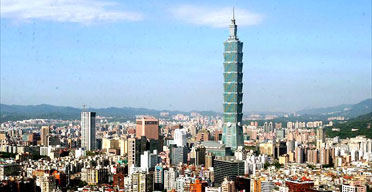Dad, What Do You Think of This?
I stole this word for word (including the photo) from the The Guardian, but I find it rather interesting.

Photo Caption: "At more than 500 metres, Taipei 101 in Taiwan is the world's tallest building. But now geologists fear that its size and weight may have transformed a stable area into one susceptible to earthquake activity. Photograph: Wally Santana/AP"
Taipei 101 is a building with a lot to boast about. Standing 508 metres (1,667ft) high, it is the world's tallest. And at 700,000 tonnes, it must be among the heaviest.
But the sheer size of the Taiwan skyscraper has raised unexpected concerns that may have far-reaching implications for the construction of other buildings and man-made megastructures. Taipei 101 is thought to have triggered two recent earthquakes because of the stress that it exerts on the ground beneath it.
According to the geologist Cheng Horng Lin, from the National Taiwan Normal University, the stress from the skyscraper may have reopened an ancient earthquake fault. If he is right, then it raises concerns about proposals such as Sky City 1000 in Japan, the vertical city that has been proposed to solve Tokyo's housing problems. And it is not just skyscrapers that are a problem. Dams and underground waste deposits may also cause rumblings if they become too large.
Before the construction of Taipei 101, the Taipei basin was a very stable area with no active earthquake faults at the surface. Its earthquake activity was similar to parts of the UK, with micro-earthquakes (less than magnitude 2) happening about once a year.
However, once Taipei 101 started to rise from the ground, things changed. "The number of earthquakes increased to around two micro-earthquakes per year during the construction period (1997 to 2003).
"Since the construction finished there have been two larger earthquakes (magnitude 3.8 and 3.2) directly beneath Taipei 101, which were big enough to feel," says Dr Lin.
Using the construction information, Dr Lin has calculated how much pressure Taipei 101 exerts on the ground. The weight of steel and concrete came to more than 700,000 tonnes. This is spread over an area of 15,081 square metres (3.7 acres), meaning that it exerts a huge pressure of 4.7 bars on the ground below. "The construction of Taipei 101 is totally different to many other high-rise buildings because it used hybrid structures made of both concrete and steel, to give it added protection from earthquakes and fire. Therefore it has a huge vertical loading on its foundation," says Dr Lin.
And it is this exceptional downward stress that Dr Lin thinks may have caused the extra earthquakes.
"I think that the considerable stress might be transferred into the upper crust due to the extremely soft sedimentary rocks beneath the Taipei basin. Deeper down this may have reopened an old earthquake fault," suggests Dr Lin in his paper, published in the journal Geophysical Research Letters.
Other experts are more cautious about blaming the skyscraper for the earthquakes. "A building will change the stress on the ground under the building, but this probably won't reach down to around 10km, the level where the earthquakes occurred," says John Vidale, an earthquake expert at the University of California in Los Angeles.
Zygmunt Lubkowski, an earthquake analyst for the engineering firm Arup, is concerned at the lack of data. "Earthquakes occur on timescales of thousands to millions of years. From just 10 years of earthquake data it is hard to tell if the extra earthquakes are just noise in the signal or due to the building."
Many engineers and scientists are more perturbed about the impact of other types of construction. "It is well known that man can induce earthquakes from things like mining, building reservoirs and extracting oil and gas, where a large load acts over a large area," says Dr Lubkowski.
One of the most convincing examples is the Koyna Dam earthquake, which occurred in 1967. More than 120 people died and many more were injured when a magnitude 6.5 earthquake shook the ground around the recently constructed dam in Maharashtra state, India.
It is thought that the huge weight of water changed the stresses in the ground. Closer to home, the magnitude 5 earthquake in May 2001 in the North Sea is thought to have been caused by a release in pressure from oil and gas extraction.
In 1967, mountains of waste that had been injected into the Rocky Mountains set off a magnitude 5.5 earthquake under Denver in Colorado. A similar earthquake under a nuclear waste store would be disastrous.
Meanwhile, the idea of carbon sequestration - reducing global warming by locking up carbon dioxide in holes under- ground, will be pointless if earthquakes let all the carbon dioxide escape. "Huge amounts of fluid are going to be put in large cavities and earthquakes are a real concern," says Leonardo Seeber, a geologist from the Lamont Doherty Earth Observatory in New York. "I am less worried about nuclear waste as it is more likely to be put in a small tunnels rather than huge cavities," he adds.
Compared with dams and underground waste deposits, skyscrapers such as Taipei 101 are mere pinpricks on the Earth's surface. "It is a point load which is probably going to be insignificant at depth," says Dr Seeber.


0 Comments:
Post a Comment
<< Home